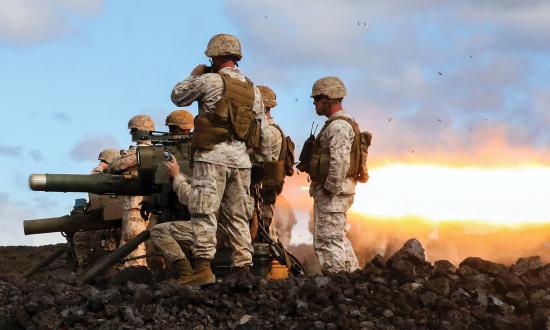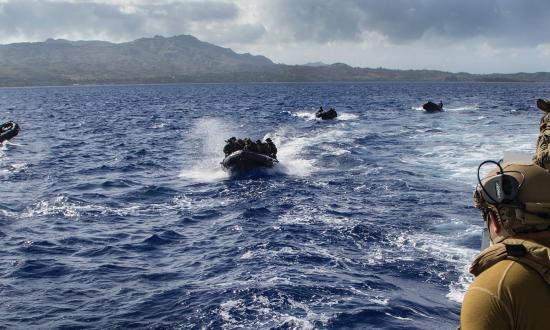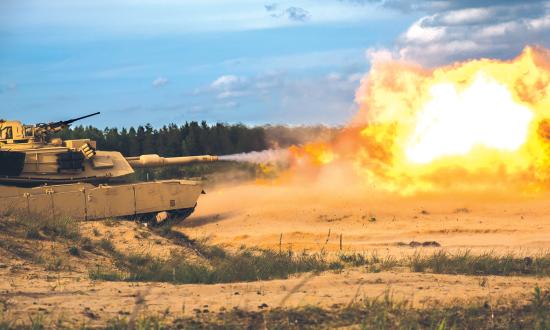The Marine Corps is shifting its focus to fighting a conventional war against China, as reflected in General David H. Berger’s 38th Commandant’s Planning Guidance. One shortcoming the Marine Corps would have in such a conflict is air defense, which General Berger recognizes: “We must continue to prioritize investments in modern, sophisticated air defense capabilities to include those capabilities which are required by our forward-deployed stand-in forces for persistence inside the adversary WEZ [weapon engagement zone].”1 To fight inside the enemy’s WEZ, integrating more and better air defense assets is only part of the answer to countering enemy air threats. The Marine Corps also must change the way it fields these assets and address the threat of enemy aircraft in individual and unit-level training.
The Chinese Threat
China’s air capabilities have vastly improved since the third Taiwan Strait crisis in 1995–96. At that time, the People’s Liberation Army (PLA) was unable even to track the USS Nimitz Carrier Strike Group as it sailed between Taiwan and mainland China, which made it clear that the PLA’s hardware was woefully inferior to that of the U.S. military.2 Since then, the PLA has updated its equipment and developed and fielded a variety of manned fixed- and rotary-wing aircraft capable of ground-attack missions, as well as various unmanned intelligence, surveillance, and reconnaissance aircraft. Though the Chinese military still lacks the quantity and quality of cutting-edge U.S. aircraft such as the F-22 and F-35, it has a substantial number of fourth-generation fighters such as the J-10 and J-11 families. It also will field ground-attack capabilities in fifth-generation fighters expected to be in service soon.3 The PLA Navy (PLAN) operates its own aircraft, including J-15 carrier-based fighters. The PLAN Marine Corps (PLANMC) also has trained with PLA Z-10 attack helicopters.4
While the PLA’s robust aviation capabilities are comparatively new, the U.S. military historically has relied on its aircraft to provide air superiority. U.S. ground forces have not faced a substantial enemy air threat in any conflict since World War II. Because of this, the Marine Corps’ air defense capability has been limited and today has almost completely evaporated since the retirement of the air defense variant of the light-armored vehicle (LAV-AD). Currently, Marine Corps air defense weapons reside exclusively in low-altitude air defense (LAAD) battalions armed with the Stinger missile—a short-range, shoulder-fired man-portable air defense system (MANPADS). There are only two LAAD battalions, with a third expected to be reactivated soon. While this is a move in the right direction, even three LAAD battalions are sorely inadequate in quantity and capability
to provide sufficient air defense in a fight with the Chinese military.
If the Marine Corps had to seize a Pacific island today to establish an expeditionary advanced base (EAB), the assault force would fall under the umbrella of Navy air defense systems, including the Aegis combat system, during its ship-to-shore movement. Once on the beach and beyond, however, the Marine Corps will need to be able to provide its own air defense. This will require highly mobile platforms that can keep up and integrate with maneuver units.
Fielding New Platforms
Multiple companies have developed new systems to meet this need using lasers, jammers, guns with airburst munitions, and missiles.5 Some systems even combine multiple weapons to create a combined-arms approach to engaging aircraft. The Marine Air Defense Integrated System (MADIS) proved that nonkinetic methods can be used against unmanned threats by achieving a soft kill against an Iranian drone in 2019.6 Integrating directed-energy weapons, jammers, and conventional missiles and guns would provide a flexible system capable of dealing with a multitude of threats as well as putting an enemy’s air assets in a combined-arms dilemma—something existing Chinese air defense vehicles already do.7
As new antiair systems are developed and tested, they also must be integrated in a way that minimizes the logistical burden on Marine ground forces. Some systems in testing use prime movers already in service with the Marine Corps, such as the joint light tactical vehicle (JLTV).8 This means that maintenance and logistical support for the vehicles will not require additional training for personnel. For example, the MRZR combat vehicle is already in active service with the Marine Corps, and the MADIS system used to destroy the Iranian drone was mounted on one.9 The retired LAV-AD was based on the same hull as the rest of the LAV family and could be brought back into service until a replacement vehicle is developed. Another possibility for a replacement platform would be a new variant of the amphibious combat vehicle (ACV). With a payload of 7,280 pounds, the ACV could be used to create a ship-to-shore–capable air defense vehicle.10
Once a new antiaircraft vehicle has been fielded, it must be integrated with maneuver units’ tables of organization. A platoon of vehicles at an infantry battalion level would be able to keep up with and provide protection for infantrymen close to the forward line of troops. This level of integration must be trained and rehearsed to ensure the vehicles stay close enough for their weapon systems to protect the force from aerial threats.
Though designed specifically to engage aircraft, air defense vehicles also can provide fire support for ground troops. The Soviet-designed ZSU-23-4 and LAV-AD both have been used to engage ground targets. Because they can elevate their guns to a high angle (usually 80 degrees or higher), they can engage even targets in urban areas or mountainous terrain. Their high rates of fire enable them to reduce buildings and destroy any target short of a heavily armored tank. During the Battle of Grozny, Chechen fighters would fire rocket-propelled grenades from rooftops or basements where Russian tanks could not bring their guns to bear. This inflicted significant casualties, prompting a change in Russian tactics: Self-propelled antiaircraft vehicles were used to support tanks in urban combat to cover the dead space of the tanks’ weapon systems.11
Integrating Army Defense Systems
While a vehicle-based, short-range air defense system would improve air defense capabilities for Marine ground forces, EABO will require more capable air defense assets to protect against PLA assets. Guns and short-range missiles can destroy rotary- and tactical fixed-wing aircraft, but they cannot engage Chinese ballistic missiles and strategic bombers.12
One way to counter this threat would be to make EABO an interservice operation. This would allow the Marine Corps to leverage the Army’s Terminal High-Altitude Area Defense (THAAD) missile-defense system, which can integrate with Aegis and disaggregate its launcher from the rest of the system, making it more survivable as well as more difficult to detect and target.13 Incorporating these systems would enable EABs to defend themselves not just from tactical aircraft, but from Chinese ballistic and cruise missiles as well. Equipping EABs with missile-defense capabilities not only would allow for their own self-defense, but also would bolster the protective screen provided by Aegis-equipped ships for U.S. aircraft carriers and big-deck amphibious ships against threats such as the DF-21D.14
Increasing Training
Fielding new platforms and integrating existing Army systems should be only part of improving Marine Corps air defense capabilities. The Marine Corps largely overlooks passive air defense. This can be improved by starting with individual training. Entry-level training should teach Marines passive air defense techniques. As a foundation, Marines should be instructed on the capabilities of modern Chinese aircraft. This does not include just armed, manned aircraft such as attack helicopters, but also unmanned aerial systems (UASs) that are becoming more widespread in the PLA.15
Marines must be taught practical measures at the individual level to reduce the chance of detection by an enemy air asset. They should practice concealment techniques such as building overhead cover in defensive positions, using thermal blankets woven in with camouflage netting, and seeking overhead concealment such as dense brush or treetops. Having Marine Corps UAS operators fly systems such as the Raven or Puma over these prepared positions will give Marines the opportunity to observe what the aircraft can see, which will reinforce their practical understanding of what is and is not effective at mitigating aerial observation.
Reinforcing such training in the fleet can drive unit standard operating procedures (SOPs) on air defense measures. Companies and battalions should practice procedures for threat aircraft, including deception measures such as decoy positions. With larger units, techniques can include active air defense measures such as antiair gunnery techniques using vehicles and firepower organic to the unit. Subsequent training should incorporate Stingers and other future air defense assets into unit SOPs.
Another shortcoming is how the Marine Corps employs its only extant air defense weapon system. Stingers currently are used by only one Marine occupational specialty (MOS) (which is exclusive to the LAAD battalions). As a result, fielding these missiles with maneuver units is not common practice, and leaves infantry units with no air defense options beyond halting in place and hoping the threat aircraft cannot detect them. Arming them with Stingers would provide an option to fight back against aircraft rather than merely sitting as targets.
To increase the distribution of Stingers to maneuver units, infantrymen also should be trained on how to fire them. While such a change would add to the required training courses infantry Marines must attend, not every infantry Marine would have to be trained—only a handful per rifle company would have to be sent to a LAAD gunner course to provide an air defense capability to each unit. Infantry units already send select Marines to advanced courses outside their specific MOSs; sending an infantry Marine to a Stinger gunner course would be no different.
The Marine Corps needs to revitalize its air defense equipment and training. A conventional war against a peer adversary will require the Marine Corps to operate under threat of enemy air and missile attack. Fielding new air defense systems, integrating Army systems, and updating training to address active and passive air defense measures will be necessary to operate inside China’s WEZ.
1. Gen David H. Berger, USMC, Force Design 2030 (Washington, DC: Headquarters United States Marine Corps, 2020).
2. Michael J. Cole, “The Third Taiwan Strait Crisis: The Forgotten Showdown Between China and America,” National Interest, 10 March 2017.
3. Lt Gen Robert H. Ashley, USA, China Military Power: Modernizing a Force to Fight and Win (Washington, DC: Defense Intelligence Agency, 2018).
4. Jeffrey Lin and P. W. Singer, “China’s Marine Corps Is Getting Bigger and Stronger,” Popular Science, 29 March 2017.
5. Jen Judson, “Everything’s Coming Up SHORAD,” Defense News, 18 October 2017.
6. Sam LaGrone, “Marines Took Out Iranian Drone for the Cost of a Tank of Gas,” USNI News, 19 July 2019.
7. “PGZ95 (Type 95) 25mm Self-Propelled Anti-Aircraft Artillery (SPAAA) System,” Army Technology, 14 March 2011.
8. Jen Judson, “Oshkosh Makes Joint Light Tactical Vehicle More Lethal,” Defense News, 9 October 2017.
9. Sam LaGrone, “UPDATED: USS Boxer Downs Iranian Drone in ‘Defensive Action,’” USNI News, 18 July 2019.
10. “Amphibious Combat Vehicle,” BAE Systems (March 2020).
11. Dodge Billingsley, Fangs of the Lone Wolf (West Midlands, England: Helion and Company Limited, 2013).
12. Sam LaGrone and Dave Majumdar, “Chinese Weapons that Worry the Pentagon,” USNI News, 9 June 2014.
13. “Lockheed Martin’s THAAD System Successfully Demonstrates Remote Launcher Capability During Intercept Test,” Lockheed Martin, 30 August 2019.
14. Mallory Shelbourne, “U.S. Admiral: China Can ‘Keep Pouring Money’ Into Anti-Ship Ballistic Missiles,” USNI News, 27 January 2021.
15. Elsa Kania, The PLA’s Unmanned Aerial Systems (Montgomery, AL: China Aerospace Studies Institute, 2018).








